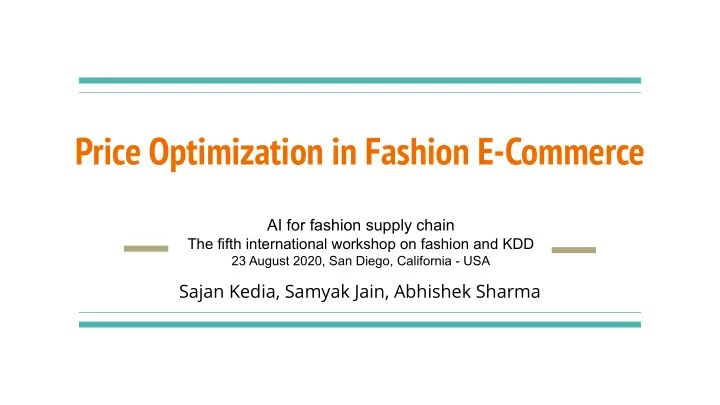

Price Optimization in Fashion E-Commerce AI for fashion supply chain The fifth international workshop on fashion and KDD 23 August 2020, San Diego, California - USA Sajan Kedia, Samyak Jain, Abhishek Sharma
Problem Statement - Biggest challenge to the e-commerce companies is to set an optimal price for all the products on the platform daily. - Specifically fashion e-commerce is very price sensitive and shopping behaviour heavily relies on discounting. Starting from the product discovery to the final order, discount and the price point is the main conversion driving factor. - Finding an optimal price point for all the products is a critical business need which maximizes the overall revenue.
Methodology The solution comprises of 3 major components : ● Demand Prediction Model ● Price Elasticity of Demand ● Linear Programming Optimization
Architecture Diagram
Demand Prediction Model - It generates demand for all the products for tomorrow at the base discount value. - Model: - Linear regression, Random Forest regressor, XGBoost, MLP - Sequence Model: LSTM - Temporal behaviour: ARIMA - Extensive Feature Engineering is done to come up with an accurate demand prediction model.
Feature Engineering
Feature Engineering Observed Features : browsing data like list count, product display count, quantity sold, cart ● count, total inventory, etc. It captures the visibility aspects of the products which are directly correlated with the demand for the product. Engineered Features : Multiple features were handcrafted. Ex: affinity of a customer for a ● particular brand, ratio of total quantity sold at a BAG level and the sum of quantity sold for entire platform is calculated, elasticity value for each product is also calculated etc. Sort Rank : Since quantity sold is highly dependent on the search ranking of the product, this ● feature is also added. Product Embedding: From the clickstream data, the user-product interaction matrix is ● generated. Skip-gram based model is applied to the interaction matrix, which captures the hidden attributes of the products in the lower dimension latent space. Word2Vec is used for the implementation purpose.
Comparative Performance of Various Models Model MAE RMSE Linear Regression 0.207 0.732 Random Forest Regressor 0.219 0.854 XGBoost 0.195 0.847 Multilayer Perceptron 0.254 1.471 Ensemble 0.192 0.774 LSTM 0.221 0.912 ARIMA 0.258 1.497
Price Elasticity of Demand - From the demand model, we get the demand for a particular product on its base discount. - Now, in order to get the demand for a product at a different price point, we use the concept of price elasticity of demand.
Price Elasticity of Demand The formula for calculating price elasticity of demand is given by: Where: 𝑅 original demand 𝑄 price for the product Δ 𝑅 change in demand as the price changes Δ 𝑄 change in the product’s price. - Elasticity is computed for each product based on the historical price-demand pairs.
Integer Programming Optimization - After applying the price elasticity of demand we get 3 different price points for a product and the corresponding demand at those price points. - Now we need to choose one of these 3 prices such that the net revenue is maximized. Thus, the problem boils down to an optimization problem and we come up with the following integer problem formulation:
Linear Programming Optimization - The integer problem formulation is computationally intractable. - Thus we convert it to a linear programming problem, by treating x as continuous variable. This technique is called linear relaxation. - The solution obtained from this problem acts like a linear bound for the integer formulation problem.
Linear Programming Vector Computation
A/B Test Results % increase in revenue GM % uplift Test 1 0.96% 0.99% Test 2 1.96% 0.95% Test 3 0.09% 0.49% Test 4 3.27% -0.41% Test 5 7.05% 0.15%
Thank You !!
Recommend
More recommend